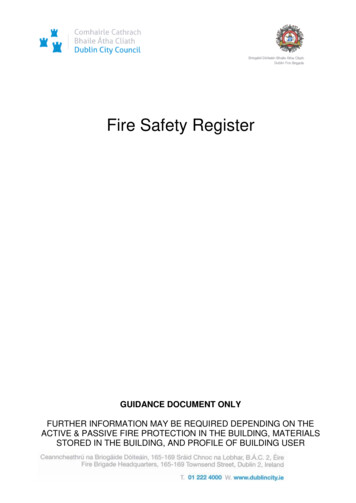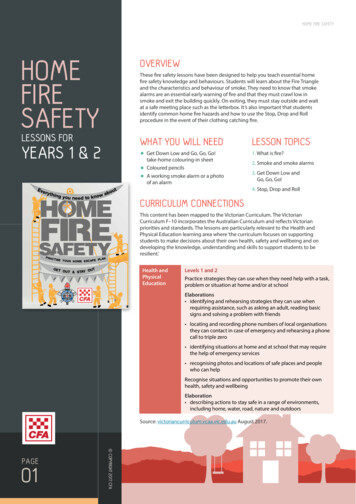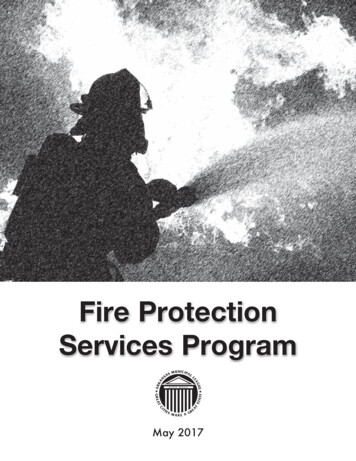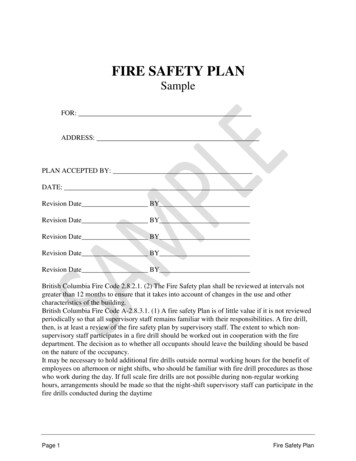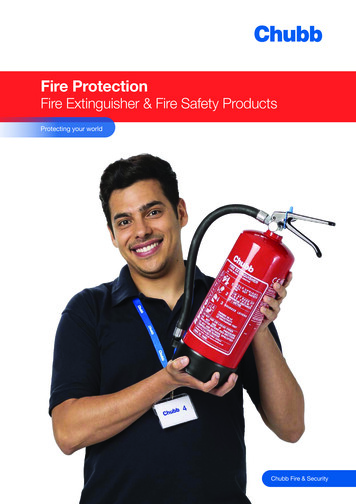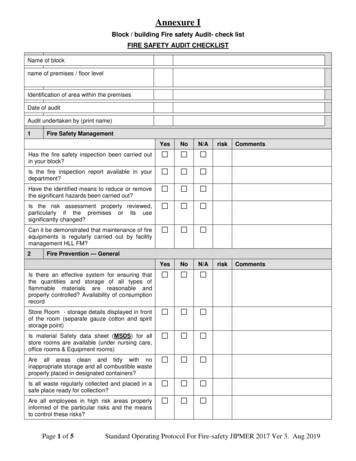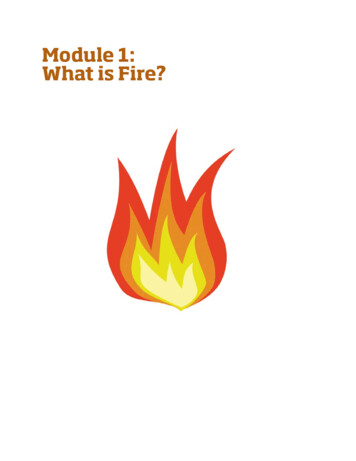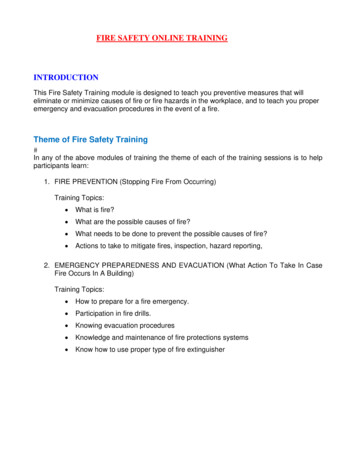
Transcription
FIRE SAFETY ONLINE TRAININGINTRODUCTIONThis Fire Safety Training module is designed to teach you preventive measures that willeliminate or minimize causes of fire or fire hazards in the workplace, and to teach you properemergency and evacuation procedures in the event of a fire.Theme of Fire Safety Training In any of the above modules of training the theme of each of the training sessions is to helpparticipants learn:1. FIRE PREVENTION (Stopping Fire From Occurring)Training Topics: What is fire? What are the possible causes of fire? What needs to be done to prevent the possible causes of fire? Actions to take to mitigate fires, inspection, hazard reporting,2. EMERGENCY PREPAREDNESS AND EVACUATION (What Action To Take In CaseFire Occurs In A Building)Training Topics: How to prepare for a fire emergency. Participation in fire drills. Knowing evacuation procedures Knowledge and maintenance of fire protections systems Know how to use proper type of fire extinguisher
GOALSThe goals of Fire Safety For Employees Online Training is to ensure that FAU Personnel: Understand the major causes of fires in the work placeLearn how to prevent firesLook for possible fire hazards and report themBe aware of fire safety devices in their office and buildingBe familiar with the building's emergency proceduresKnow what to do if a fire breaks outLearn how to evacuate quietly and calmlyOTHER INFORMATION This training session has no time limit.Once you begin the final quiz complete it entirely. Unanswered questions are counted wrong.You will be notified of your results and a certificate will be issued upon satisfactory completion.A help button is located in the lower left corner of every page that will allow you to email questionsor comments to the person in charge of the training.FIRE SAFETY PROGRAMThe Fire Safety Training Program at Florida Atlantic University has been developed andimplemented to comply with regulations, and to establish and maintain a fire safe workingenvironment for employees.At the core of the program is the education and knowledge which we believe is the key to savelives, test and train occupants in fire safety awareness, and bring a higher level ofunderstanding of what is involved in order to prevent and more importantly SURVIVE A FIRE.In essence the goal is to provide knowledge so as to understand the origin of fires, sources offires, how to prevent fires from occurring and finally what to do if one is faced with fire.Fire Prevention Plan:The purpose of the plan is to eliminate the causes of fire and prevent loss of life and property byfire. The plan provides faculty, staff and students with information and guidelines which willassist in recognizing, reporting and controlling as well as eliminating the causes of fires and firehazards.
Program Elements will include:1. Identifying potential fire hazards one of which is the proper handling of combustible andflammable materials.2. Control and proper usage of ignition sources mainly electricity which is the major ignitionsource in all occupancies. Ignition sources also exist in chemical and mechanical forms.Smoking, open flames like candles and hot burners as well heat producing elements.The fire safety training is organized in such a way as to meet the specific needs of groups ofpeople based on the kind of fire hazards to which they are exposed. This online training can beused for training office employees as well as those who work in laboratories.Fire Safety Training for Office EmployeesWorkplace fire safety guidelines are primarily derived from the National Fire ProtectionAssociation’s Life Safety Code (NFPA 101) and the Occupational Safety &HealthAdministration’s (OSHA) regulations contained in Title 29, part 1910, Subpart E. of the Code ofFederal Regulations. These regulations apply to buildings and work areas and provide basicrequirements for the protection of property and life and the prevention of fires and explosions.OSHA requires employers to have a Fire Prevention Plan and to inform their employees of firehazards to which they are exposed upon initial assignment of their jobs.This Fire Prevention and Emergency Evacuation training has been developed to comply withthe above regulations and guidelines. EMPLOYEES WILL BE TRAINED ABOUT THE FIREPREVENTION PLAN AND EMERGENCY EVACUATION PROCEDURES of their work place,understand the threat and power of fire, and learn what to do in case of fire. This includes beingfamiliar with basic fire protection systems including the basics of fire extinguishers and how touse them. All faculty, staff and students participate in this training.Fire Safety Training for Laboratory EmployeesFires and explosion are the most serious physical hazards faced in typical chemistry labs aswell as in other labs and research and experiment settings. The concentration of fuel loads inthe form of flammable and combustible liquids as well as the existence of highly pressurizedcylinders of different kinds; together with different kinds of ignition sources that are used foroperation classify laboratories to be high hazard areas to work.Training will outline how to prevent fire in lab setting which will outline on the handling offlammable and combustible liquids including hazardous waste materials (fuel loads)
containment of ignition sources be electrical, chemical, or mechanical. It also addresses theproper procedures to follow for preparing for a fire emergency and what to do should a fireemergency occur. A hands-on fire extinguisher training and knowing the different types of fireextinguisher is also an important part of the training module. Lab supervisors, technicians,student and faculty members who teach and work in labs participate in this training.Fire losses are costly to the community. Fire destroys property and can cause injury, fatalities,and interrupt operations. Statistics show that you will come face to face with a hostile fire fourtimes during your lifetime. It is not uncommon for people to panic and behave in an irrationalmanner when an emergency situation occurs unless they have received emergency responsetraining. Fires in the work place happen. Therefore it is important for employees to understandoffice fire prevention and evacuation procedures.PART ONE - FIRE PREVENTIONIn this part of the training module you will learn the major causes of fire in the workplace and tips on how to prevent them.
What are some of the causes of fire on campus? IMPROPER DISPOSAL OFSMOKING MATERIALS ELCTRICAL FIRES CAUSED BYOVERLOADED ELECTRICALOUTLETS AND EXTENSIONCORDS SPACE HEATERS AND OTHERHEAT PRODUCING ELEMENTS OPEN FLAMES AND CANDLES HANDLING AND STORAGES OFFLAMMABLES ANDCOMBUSTIBLE LIQUIDS UNSUPERVISEDCOOKING/MICROWAVING ARSONSMOKING IS PROHIBITED INALL FAU FACILITIES.
FIRE SAFETY ONLINE TRAININGPREVENTIVE MEASURESPrevention is the best way to stop fires from occurring in the work place. Follow thesesimple steps to avoid creating a fire hazard. If you observe a fire hazard, correct it if youcan or report it to your supervisor for immediate attention.HOUSEKEEPINGKeep all stairways and passagewaysleading to and from exits free of allobstructions at all times. Furnishings,decorations, combustible objects orflammables cannot obstruct access to oregress from exits.Do not obstruct sprinkler heads or pilematerials around fire extinguishers, firealarm pull stations, or sprinkler and standpipe control valves. A minimum of 18 inchesof clear space is required below sprinklerdeflectors to obtain proper distribution ofwater.Make sure you dispose of all trash as soonas possible in trashcans or dumpsters.Waste materials must never be piled incorridors or stairwells while awaiting removal.Keep fire doors closed at all times unlessthey are held open by an approved deviceconnected to the fire alarm system.
FIRE SAFETY ONLINE TRAININGPREVENTIVE MEASURESELECTRICAL WIRINGMulti-outlet electrical taps used to obtain more walloutlet capacity can result in overloaded circuits andfire. You should avoid using these devices. If youneed to use one for temporary purposes, you or theoperator of the equipment should periodically checkthe device and outlet to ensure that overheating isnot occurring.Extension cords cannot be used on campus. If youneed to use an extension cord for temporarypurposes, a surge protector is allowed. You shouldcheck the cords and the outlets periodically to ensureoverheating is not occurring. Surge protectors shouldnever be tacked, stapled, tied, hidden under rugs ordrapes, over pipes or other supports, fastened to orthrough woodworks, ceilings, or walls.Multi-outlet Electrical TapSurge ProtectorsElectrical equipment and devices should always be inspected periodically to ensureproper use and safe conditions. Be sure that all electrical equipment is properly grounded. Ifyou see any evidence of frayed, cracked, or otherwise damaged wiring or electrical outlets, theequipment affected should be taken out of service until repairs can be made.MULTI-OUTLET TAPS AND SURGE PROTECTORS CANNOT BE USED FORFIXED WIRING. WHEN THERE IS A PERMANENT NEED OF ANELECTRICAL OUTLET, ONE SHOULD BE INSTALLED.PREVENTIVE MEASURESELECTRICAL APPLIANCESNever leave space heaters, coffee makers, and all other appliances with exposed heatingelements unattended while in operation. Do not place space heaters under desks or in otherenclosed areas. Unplug appliances after each use, and store them only after they are coolenough to touch. Do not operate appliances near combustible materials such as files, trashcontainers, etc.OTHER SERIOUS LIFE SAFETY HAZARDS
The use of large open flames, bonfires, and use of candles etc.Open flames are not permitted on campus without making prior arrangements withEH&S and obtaining permits from the Boca Raton Fire Department. This isnecessary to provide contingency in case of an emergency. The use and storage of explosives, fireworks, or incendiary materials:The use and storage of these items are prohibited except with prior approval ofEH&S. Such approval shall be contingent upon the parties involved complying withthe applicable laws, regulations and ordinances of the Federal, State and localgovernments. Storage in boiler, furnace, electrical switch, and mechanical rooms:These high hazard heavy equipment areas shall not be used for storage and must beclear of debris at all times. Pipe and duct chase spaces and other vertical openingswithin a building shall not be used for storage.APPROVED STORAGE AREAS shall have materials properly stacked, interlocked, andsegregated to eliminate safety hazards. . Any storage must be placed 36 inches fromfire safety equipment or devices and electrical panels. Storage in or beneath stairwellsin buildings is not permitted. Storage room doors should be self-closing and lockableto prevent unauthorized entry. Aisles in storage areas need to be at least 36 incheswide.Where storage places are provided with automaticextinguishing systems, there shall be clearance ofat least 18 inches between the top of the storageand sprinkler heads to prevent interference withwater spray.
FIRE SAFETY ONLINE TRAININGOFFICE BUILDINGS FIRE SAFETY FACILITIESBe familiar with fire protection systems and their locations.Modern office buildings are designed with fire detection and suppression facilities to protect lifeand property from fire. Fire safety facilities include sprinkler systems, smoke alarms andheat detectors.SMOKE DETECTORHEAT DETECTORSPRINKLERSmoke detectors sense when there is smoldering material and activate a warning alarm.Heat detectors warn of fire when the temperature in the area around the heat detector reachesa certain level. Heat detectors do not detect smoke.Sprinklers are sensitive to heat and release water automatically when there is a fire to dousethe flames.Heat and smoke detectors in a building are linked to a fire alarm control panel. The controlpanel will indicate the floor and room location, as well as the device activated when a firesensor or manual alarm is set off.A fire alarm sounds when the alarm control panel activates. At FAU, a dispatcher in the PoliceDepartment electronically monitors the control panels. The dispatcher immediately notifies theFire Department.
FIRE SAFETY ONLINE TRAININGPART TWO: EMERGENCY EVACUATION PLANNINGIn this part of the training module, you will learn how to plan ahead and become familiarwith emergency equipment.It is your responsibility to plan two evacuation routes.Fire and smoke can spread quickly. In the event of a fire, you may have very little time toevacuate before fire and smoke prevent your escape. For your safety it is important to plan atleast two evacuation routes. These are your primary and secondary exits. If you are unable toexit the building using your primary route, you should be able to exit using a secondary route.When you are planning your emergency evacuation routes, remember that elevatorsshould not be used.Three reasons for not using an elevator:1.2.3.Power loss can cause you to become trapped.You could stop on a floor experiencing fire conditions.In a fire some elevators are reserved for use by the fire department.
FIRE SAFETY ONLINE TRAININGKNOW THE LOCATION OF EMERGENCY EQUIPMENT.FIRE ALARM PULL STATIONSPull stations are typically located by exits and are used tosound the fire alarm. Look for them and remember wherethey are located.FIRE EXTINGUISHERSPortable fire extinguishers are available throughout FAUbuildings. Know where they are located in your area. Youcan use a fire extinguisher to put out a fire only if it safe todo so, and if you have been trained by EH&S.EMERGENCY PHONEIf there is a fire in your building, you may not have time to call 911 before you have to evacuate. You shouldknow the location of a phone that is a safe distance from your building that you could use to report the fire.
FIRE SAFETY ONLINE TRAININGEVACUATION PLAN AND EMERGENCY INFORMATIONEmergency information should be displayed in a visible location in the building for aquick reference in case of an emergency. This information includes: Evacuation routes Evacuation guidelines Emergency telephone numbersDESIGNATED ASSEMBLY AREAS
FIRE SAFETY ONLINE TRAININGINDIVIDUALS REQUIRING ASSISTANCEIt is recommended that individuals requiring assistance prepare for emergencies ahead of timeby learning the locations of exit corridors and exit stairways, planning an escape route, andshowing a co-worker or instructor how to assist them in case of an emergency. In addition,people who cannot speak loudly should carry a whistle or have some other means of attractingthe attention of others.As part of emergency planning, safe areas of refuge for building occupants with disabilitiesshould be identified. In the event of a fire, individuals requiring assistance are encouraged toseek shelter in an area of refuge until emergency personnel come to evacuate them.An area of refuge is a place in a building that is constructed to be fire resistant and wherepersons will be sealed off from fire and smoke. Recommended areas of refuge are exitcorridors and stairwell landings
FIRE SAFETY ONLINE TRAININGPART THREE: EMERGENCY PROCEDURESIn this part of the training module you will learn what to do in the event of anemergency.In the event of a fire, bomb threat, hazardous material spill, etc. follow the following steps:Step one ACTIVATE THE FIRE ALARM SYSTEM LOCATED ALONG EXIT ROUTESIf the alarm is sounding, turn off all hazardous experiments or procedures beforeevacuating. If possible, take or secure all valuables, wallets, purses, keys, etc.Step two EVACUATE THE BUILDINGFollow your evacuation plan and leave the building using the nearest exit or stairway. Donot use the elevators. As you leave the building, move away from the exits.Step three CALL 911 FROM A SAFE AREAProvide your name and the location and nature of the emergency. Proceed immediatelyto the designated assembly point for your work area. Report for a roll call as soon asyou arrive so officials know you are safe. REMAIN AT A SAFE LOCATIONStay at least 100 feet from the building until you are told to re-enter. Do not impedeaccess of emergency personnel to the area.FIGHTING A FIREYou should not attempt to fight a fire unless: You have received specific training in the use of fire extinguishers.The building fire alarm is activated to alert others.You have called 911.There is an escape exit or route behind you.You know the fire extinguisher is fully charged.You know what is burning and what type of extinguisher to use.There is no toxic smoke present.The fire is not spreading rapidly.
FIRE SAFETY ONLINE TRAININGEMERGENCY PROCEDURESINDIVIDUALS REQUIRING ASSISTANCEIndividuals requiring assistance should go to their area of refuge and request assistance fromothers.Able-bodied persons should assist in the evacuation of the individuals who require assistance.The assistance may be in the form of the following: Be familiar with the people requiring assistance who are routinely in your work area.Inform hearing impaired people that they have to evacuate.Assist visually impaired people to an exit stairway.Inform emergency personnel of the location of people inside the building who needhelp evacuating.In the extreme case that you must physically evacuate a person, ask how to safelycarry/assist them.To complete the training you must click here to take the Fire Safety Quiz.
The goals of Fire Safety For Employees Online Training is to ensure that FAU Personnel: Understand the major causes of fires in the work place Learn how to prevent fires Look for possible fire hazards and report them Be aware of fire safety devices in their office and building Be familiar with the building's emergency procedures



